Overview
The Grant Museum of Zoology and Comparative Anatomy was established in 1828 by Robert Edmond Grant (1793-1874) to serve as a teaching collection at the newly founded University of London (later University College London).
Grant was best known during his time for his work on marine invertebrates, in particular sponges, sea pens and molluscs. His work on sponges established once and for all that they were animals and coined the term Porifera. It was this work and his radical evolutionary views that influenced the young Charles Darwin during the latter’s second year at Edinburgh University (1826-1827) where Grant taught medicine. At the age of 35, Grant moved down to London to take up the chair at the University of London and he stayed there until his death in 1874. He was the first Professor of Zoology and Comparative Anatomy in England and upon arrival at the University found no teaching materials with which to conduct his courses. He immediately began to amass specimens, material for dissection, diagrams and lecture notes and these form the basis of the Museum today.
The Grant Museum of Zoology and Comparative Anatomy was established in 1828 by Robert Edmond Grant (1793-1874) to serve as a teaching collection at the newly founded University of London (later University College London).
Grant was best known during his time for his work on marine invertebrates, in particular sponges, sea pens and molluscs. His work on sponges established once and for all that they were animals and coined the term Porifera. It was this work and his radical evolutionary views that influenced the young Charles Darwin during the latter’s second year at Edinburgh University (1826-1827) where Grant taught medicine. At the age of 35, Grant moved down to London to take up the chair at the University of London and he stayed there until his death in 1874. He was the first Professor of Zoology and Comparative Anatomy in England and upon arrival at the University found no teaching materials with which to conduct his courses. He immediately began to amass specimens, material for dissection, diagrams and lecture notes and these form the basis of the Museum today.
Grant set the precedent that the Chair of Zoology was also the curator of the comparative zoology collection. On his death Grant was persuaded to leave his library and collection of 10,000 specimens to the College. Over the years the Museum's Curators have included many great zoologists, embryologists and palaeontologists among them Edwin Ray Lankester, J. P. Hilland and D. M. S. Watson. A full history of the Museum's Curators can be found in the On Origin of Our Specimens blog series.
Amenities
- Places to go
- Museums


